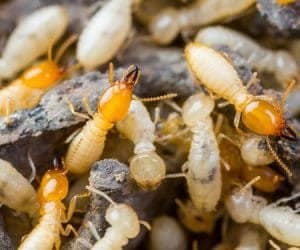Signs of Termite Infestation: How to Detect and Prevent Serious Damage
Termites are silent invaders, wreaking havoc on homes and structures before most people even realize they’re there. Early detection is crucial in preventing significant damage to your property. In this blog, we’ll guide you through the key signs of termite infestation and provide actionable tips to protect your home from these destructive pests.
What Are Termites and Why Are They Dangerous?
Termites are small, wood-eating insects that can cause severe structural damage to buildings by feeding on cellulose, the primary component of wood. They work quietly, which means infestations can often go unnoticed for months or even years, leading to costly repairs. Termites are particularly notorious in warm and humid climates, where they thrive and reproduce rapidly.
Because they primarily live inside walls or deep within wooden structures, early signs of termite infestation can be difficult to spot, but there are several red flags that homeowners can look for to stay ahead of these destructive pests.
Key Signs of a Termite Infestation
Mud Tubes on Exterior Walls or Foundations
One of the most common signs of termite activity is the presence of mud tubes. Termites build these small, pencil-sized tunnels from soil and saliva to travel from their colonies to food sources. These tubes can typically be found along the exterior walls or foundation of a building. If you see them, it’s a strong indicator that termites are active in the area.
Hollow-Sounding Wood
If you knock on wood in your home and it sounds hollow, this could be a sign of termites. Since termites eat wood from the inside out, the external surface may appear fine while the interior has been significantly damaged. Tapping on beams, flooring, or window frames can reveal this issue, often showing how far the infestation has progressed.
Discarded Wings Near Doors or Windows
After mating, termites shed their wings. If you find piles of discarded wings near windows, doors, or other entry points, this is a likely sign that termites have entered your home. These wings are often small, translucent, and can easily go unnoticed if not carefully inspected.
Swollen Floors or Ceiling
Termite damage can cause floors or ceilings to become swollen or uneven. As termites burrow through wood, they compromise its structural integrity, leading to bulging or buckling in floors and ceilings. This type of damage is often mistaken for water damage, but it can actually be caused by termites feeding on the support beams.
Visible Wood Damage
Visible signs of wood damage, such as small holes, sagging, or blistering wood, are direct evidence of a termite infestation. Termites often create small holes when they enter or exit their feeding sites. If left unchecked, this damage can spread quickly, compromising the structural integrity of your home.
Termite Droppings (Frass)
Termite droppings, also known as frass, are another telltale sign of an infestation. These tiny, pellet-like droppings are often found near the areas where termites are feeding. Frass is typically dry, has a sawdust-like appearance, and can accumulate in piles near wooden structures. If you see something that resembles piles of sand or sawdust, it may actually be termite droppings.
Clicking Sounds in the Walls
If you hear faint clicking sounds coming from within your walls, it could be termites. Soldier termites often bang their heads against the wood or shake their bodies as a way of communicating with the colony, especially when the colony feels threatened. If you hear unusual sounds in your walls, it’s worth investigating further.
Tight-Fitting Doors and Windows
As termites eat away at the wood around door and window frames, the frames can become misshapen or warped. This causes doors and windows to become difficult to open or close properly. If you notice that doors or windows suddenly seem tight or are sticking, it could be due to termite activity rather than just moisture or settling.
Key Signs of a Termite Infestation
The Importance of Early Detection
Termites can cause thousands of dollars in damage to your home if left untreated. Early detection and immediate action are key to avoiding extensive repairs. Regularly inspecting your home for these signs of a termite infestation can help you catch the problem before it becomes severe.
In addition to visual inspections, consider scheduling professional termite inspections at least once a year, especially if you live in a high-risk area for termite activity. Pest control professionals use specialized tools like moisture meters and infrared cameras to detect termites that aren’t visible to the naked eye.
Detecting a termite infestation early can save you thousands of dollars in repair costs. By being vigilant for common signs like mud tubes, hollow-sounding wood, and discarded wings, you can prevent extensive damage to your home. Remember to take preventive measures such as reducing moisture, sealing cracks, and scheduling regular inspections with a pest control professional. The sooner you act, the better chance you have of keeping your home termite-free.


